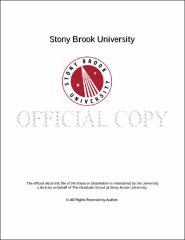| dc.identifier.uri | http://hdl.handle.net/11401/77602 | |
| dc.description.sponsorship | This work is sponsored by the Stony Brook University Graduate School in compliance with the requirements for completion of degree. | en_US |
| dc.format | Monograph | |
| dc.format.medium | Electronic Resource | en_US |
| dc.language.iso | en_US | |
| dc.publisher | The Graduate School, Stony Brook University: Stony Brook, NY. | |
| dc.type | Dissertation | |
| dcterms.abstract | This project demonstrates the importance of using research on creativity to enhance theories of people's experiences of narrative worlds. My goal was to expand theoretical accounts of the types of cognitive processes that narratives engage. The project addressed ways in which the occurrence of mysteries (gaps in readers' knowledge) prompts people to engage in creative thinking. The overarching claim is that authors invite readers to participate in mysteries, and readers often take up that call. As mysteries unfold in time, so too should the creative process. Therefore, I wrote a series of stories with mysteries, using the creative process as a template. I focused my analyses on two phases of the process--Illumination and verification-validation. During the illumination phase, a person recognizes one or many good possible solutions to a problem. In Experiments 1-3, I manipulated the outcomes of mysteries and the amount of time people had to process the solutions. The outcomes were motivated from the creativity literature and involved either convergent or divergent thinking. In Experiment 1, a reading time analysis uncovered a processing difference in response to the two types of outcomes. Specifically, divergent outcomes were more difficult to process and took people longer to read than convergent outcomes. In Experiment 2, a speak-aloud paradigm demonstrated the contents of readers' creative participation in response to the outcomes at multiple time points. Convergent outcomes caused people to express certainty, make positive appraisals, and respond with self-reflections (based on long-term memory). In contrast, divergent outcomes led people to express uncertainty, make negative appraisals, and make emotional responses. Experiment 3 explored the possible attentional component of participation in the outcomes. In Experiments 4 and 5, I added an explicit verification-validation phase to the narrative mystery process. During the verification-validation phase, a person checks potential creative solutions against some standard. I manipulated that standard by adding positive and negative character reactions to the convergent and divergent illumination outcomes. In Experiments 4 and 5, I captured reading time differences and speak-aloud responses, respectively. The results suggested that people process and participate differently in response to various creative and emotional features of narratives. | |
| dcterms.available | 2017-09-20T16:52:58Z | |
| dcterms.contributor | Gerrig, Richard J | en_US |
| dcterms.contributor | Rajaram, Suparna | en_US |
| dcterms.contributor | Freitas, Antonio | en_US |
| dcterms.contributor | Scheckel, Susan. | en_US |
| dcterms.creator | Wenzel, William George | |
| dcterms.dateAccepted | 2017-09-20T16:52:58Z | |
| dcterms.dateSubmitted | 2017-09-20T16:52:58Z | |
| dcterms.description | Department of Experimental Psychology. | en_US |
| dcterms.extent | 104 pg. | en_US |
| dcterms.format | Monograph | |
| dcterms.format | Application/PDF | en_US |
| dcterms.identifier | http://hdl.handle.net/11401/77602 | |
| dcterms.issued | 2014-12-01 | |
| dcterms.language | en_US | |
| dcterms.provenance | Made available in DSpace on 2017-09-20T16:52:58Z (GMT). No. of bitstreams: 1
Wenzel_grad.sunysb_0771E_11932.pdf: 851229 bytes, checksum: e2182460dbb0c018e34dbc49f768f9de (MD5)
Previous issue date: 1 | en |
| dcterms.publisher | The Graduate School, Stony Brook University: Stony Brook, NY. | |
| dcterms.subject | Creativity, Mysteries, Narratives, Participation, Reading, Speaking | |
| dcterms.subject | Cognitive psychology | |
| dcterms.title | Narrative Mysteries Prompt Creative Participation | |
| dcterms.type | Dissertation | |

